概述
RecyclerView 是 Android 中用于高效显示大量数据的视图组件,它是 ListView 的升级版本,支持更灵活的布局和功能。
我们创建一个RecyclerView的Adapter:
public class MyRecyclerView extends RecyclerView.Adapter<MyRecyclerView.MyHolder> {private List<String> strings;private Context context;public MyRecyclerView(List<String> strings, Context context) {this.strings = strings;this.context = context;}@NonNull@Overridepublic MyRecyclerView.MyHolder onCreateViewHolder(@NonNull ViewGroup parent, int viewType) {View view = LayoutInflater.from(parent.getContext()).inflate(android.R.layout.simple_list_item_1, parent, false);MyRecyclerView.MyHolder viewHolder = new MyHolder(view);Log.d("MyRecyclerView", "onCreateViewHolder: ");return viewHolder;}@Overridepublic void onBindViewHolder(@NonNull MyRecyclerView.MyHolder holder, int position) {holder.textView.setText("第" + position + "项");Log.d("MyRecyclerView", "onBindViewHolder: " + position);}@Overridepublic int getItemCount() {return strings == null ? 0 : strings.size();}public class MyHolder extends RecyclerView.ViewHolder {private TextView textView;public MyHolder(@NonNull View itemView) {super(itemView);textView = itemView.findViewById(android.R.id.text1);}}
}我们在onCreateViewHolder和onBindViewHolder都打印log。
onCreateViewHolder()会在创建一个新view的时候调用,onBindViewHolder()会在已存在view,绑定数据的时候调用。
我们来看一下运行时打印的log:
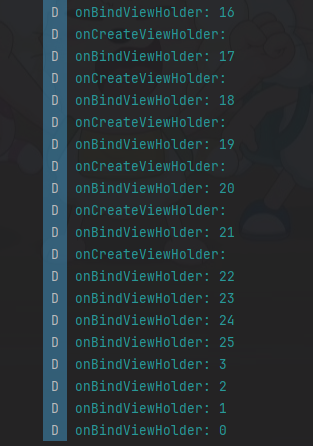
在最开始加载view的时候,两个方法onCreateViewHolder()和onBindViewHolder()都执行了,但是当我们上下滑动RecyclerView的时候,我们会发现只执行了onBindViewHolder()方法。所以说,RecyclerView并不是会一直重新创建View,而是会对view进行复用。
复用机制
当我们想去通过看源码去了解缓存复用机制的时候,我们要去想看源码的入口在哪里。上文我们提到是在滑动RecyclerView的时候进行了缓存复用,所以我们会想到去看 onTouchEvent 这个方法:
@Override
public boolean onTouchEvent(MotionEvent e) {...case MotionEvent.ACTION_MOVE: {final int index = e.findPointerIndex(mScrollPointerId);if (index < 0) {Log.e(TAG, "Error processing scroll; pointer index for id "+ mScrollPointerId + " not found. Did any MotionEvents get skipped?");return false;}final int x = (int) (e.getX(index) + 0.5f);final int y = (int) (e.getY(index) + 0.5f);int dx = mLastTouchX - x;int dy = mLastTouchY - y;if (mScrollState != SCROLL_STATE_DRAGGING) {boolean startScroll = false;if (canScrollHorizontally) {if (dx > 0) {dx = Math.max(0, dx - mTouchSlop);} else {dx = Math.min(0, dx + mTouchSlop);}if (dx != 0) {startScroll = true;}}if (canScrollVertically) {if (dy > 0) {dy = Math.max(0, dy - mTouchSlop);} else {dy = Math.min(0, dy + mTouchSlop);}if (dy != 0) {startScroll = true;}}if (startScroll) {setScrollState(SCROLL_STATE_DRAGGING);}}if (mScrollState == SCROLL_STATE_DRAGGING) {mReusableIntPair[0] = 0;mReusableIntPair[1] = 0;if (dispatchNestedPreScroll(canScrollHorizontally ? dx : 0,canScrollVertically ? dy : 0,mReusableIntPair, mScrollOffset, TYPE_TOUCH)) {dx -= mReusableIntPair[0];dy -= mReusableIntPair[1];// Updated the nested offsetsmNestedOffsets[0] += mScrollOffset[0];mNestedOffsets[1] += mScrollOffset[1];// Scroll has initiated, prevent parents from interceptinggetParent().requestDisallowInterceptTouchEvent(true);}mLastTouchX = x - mScrollOffset[0];mLastTouchY = y - mScrollOffset[1];if (scrollByInternal(canScrollHorizontally ? dx : 0,canScrollVertically ? dy : 0,e)) {getParent().requestDisallowInterceptTouchEvent(true);}if (mGapWorker != null && (dx != 0 || dy != 0)) {mGapWorker.postFromTraversal(this, dx, dy);}}} break;...return true;
}
在case:MotionEvent.ACTION_MOVE里有 scrollByInternal() 这个方法:
boolean scrollByInternal(int x, int y, MotionEvent ev) {int unconsumedX = 0;int unconsumedY = 0;int consumedX = 0;int consumedY = 0;consumePendingUpdateOperations();if (mAdapter != null) {mReusableIntPair[0] = 0;mReusableIntPair[1] = 0;scrollStep(x, y, mReusableIntPair);consumedX = mReusableIntPair[0];consumedY = mReusableIntPair[1];unconsumedX = x - consumedX;unconsumedY = y - consumedY;}if (!mItemDecorations.isEmpty()) {invalidate();}mReusableIntPair[0] = 0;mReusableIntPair[1] = 0;dispatchNestedScroll(consumedX, consumedY, unconsumedX, unconsumedY, mScrollOffset,TYPE_TOUCH, mReusableIntPair);unconsumedX -= mReusableIntPair[0];unconsumedY -= mReusableIntPair[1];boolean consumedNestedScroll = mReusableIntPair[0] != 0 || mReusableIntPair[1] != 0;// Update the last touch co-ords, taking any scroll offset into accountmLastTouchX -= mScrollOffset[0];mLastTouchY -= mScrollOffset[1];mNestedOffsets[0] += mScrollOffset[0];mNestedOffsets[1] += mScrollOffset[1];if (getOverScrollMode() != View.OVER_SCROLL_NEVER) {if (ev != null && !MotionEventCompat.isFromSource(ev, InputDevice.SOURCE_MOUSE)) {pullGlows(ev.getX(), unconsumedX, ev.getY(), unconsumedY);}considerReleasingGlowsOnScroll(x, y);}if (consumedX != 0 || consumedY != 0) {dispatchOnScrolled(consumedX, consumedY);}if (!awakenScrollBars()) {invalidate();}return consumedNestedScroll || consumedX != 0 || consumedY != 0;
}
里面的 scrollStep() 方法:
void scrollStep(int dx, int dy, @Nullable int[] consumed) {startInterceptRequestLayout();onEnterLayoutOrScroll();TraceCompat.beginSection(TRACE_SCROLL_TAG);fillRemainingScrollValues(mState);int consumedX = 0;int consumedY = 0;if (dx != 0) {consumedX = mLayout.scrollHorizontallyBy(dx, mRecycler, mState);}if (dy != 0) {consumedY = mLayout.scrollVerticallyBy(dy, mRecycler, mState);}TraceCompat.endSection();repositionShadowingViews();onExitLayoutOrScroll();stopInterceptRequestLayout(false);if (consumed != null) {consumed[0] = consumedX;consumed[1] = consumedY;}
}
scrollHorizontallyBy 与 scrollVerticallyBy :
@Override
public int scrollHorizontallyBy(int dx, RecyclerView.Recycler recycler,RecyclerView.State state) {if (mOrientation == VERTICAL) {return 0;}return scrollBy(dx, recycler, state);
}
@Override
public int scrollVerticallyBy(int dy, RecyclerView.Recycler recycler,RecyclerView.State state) {if (mOrientation == HORIZONTAL) {return 0;}return scrollBy(dy, recycler, state);
}
两个都执行的 scrollBy :
int scrollBy(int delta, RecyclerView.Recycler recycler, RecyclerView.State state) {if (getChildCount() == 0 || delta == 0) {return 0;}ensureLayoutState();mLayoutState.mRecycle = true;final int layoutDirection = delta > 0 ? LinearLayoutManager.LayoutState.LAYOUT_END : LinearLayoutManager.LayoutState.LAYOUT_START;final int absDelta = Math.abs(delta);updateLayoutState(layoutDirection, absDelta, true, state);final int consumed = mLayoutState.mScrollingOffset+ fill(recycler, mLayoutState, state, false);if (consumed < 0) {if (DEBUG) {Log.d(TAG, "Don't have any more elements to scroll");}return 0;}final int scrolled = absDelta > consumed ? layoutDirection * consumed : delta;mOrientationHelper.offsetChildren(-scrolled);if (DEBUG) {Log.d(TAG, "scroll req: " + delta + " scrolled: " + scrolled);}mLayoutState.mLastScrollDelta = scrolled;return scrolled;
}
里面的 fill 方法最为关键:
int fill(RecyclerView.Recycler recycler, LinearLayoutManager.LayoutState layoutState,RecyclerView.State state, boolean stopOnFocusable) {...while ((layoutState.mInfinite || remainingSpace > 0) && layoutState.hasMore(state)) {layoutChunkResult.resetInternal();if (RecyclerView.VERBOSE_TRACING) {TraceCompat.beginSection("LLM LayoutChunk");}layoutChunk(recycler, state, layoutState, layoutChunkResult);if (RecyclerView.VERBOSE_TRACING) {TraceCompat.endSection();}if (layoutChunkResult.mFinished) {break;}layoutState.mOffset += layoutChunkResult.mConsumed * layoutState.mLayoutDirection;/*** Consume the available space if:* * layoutChunk did not request to be ignored* * OR we are laying out scrap children* * OR we are not doing pre-layout*/if (!layoutChunkResult.mIgnoreConsumed || layoutState.mScrapList != null|| !state.isPreLayout()) {layoutState.mAvailable -= layoutChunkResult.mConsumed;// we keep a separate remaining space because mAvailable is important for recyclingremainingSpace -= layoutChunkResult.mConsumed;}if (layoutState.mScrollingOffset != LinearLayoutManager.LayoutState.SCROLLING_OFFSET_NaN) {layoutState.mScrollingOffset += layoutChunkResult.mConsumed;if (layoutState.mAvailable < 0) {layoutState.mScrollingOffset += layoutState.mAvailable;}recycleByLayoutState(recycler, layoutState);}if (stopOnFocusable && layoutChunkResult.mFocusable) {break;}}if (DEBUG) {validateChildOrder();}return start - layoutState.mAvailable;
}
这个方法功能是填充给定的布局,通过while循环不断进行填充,其中的 layoutChunk() 方法:
void layoutChunk(RecyclerView.Recycler recycler, RecyclerView.State state,LayoutState layoutState, LayoutChunkResult result) {View view = layoutState.next(recycler);//获取下一项需要布局的视图if (view == null) {if (DEBUG && layoutState.mScrapList == null) {throw new RuntimeException("received null view when unexpected");}// if we are laying out views in scrap, this may return null which means there is// no more items to layout.result.mFinished = true;return;}RecyclerView.LayoutParams params = (RecyclerView.LayoutParams) view.getLayoutParams();if (layoutState.mScrapList == null) {if (mShouldReverseLayout == (layoutState.mLayoutDirection== LayoutState.LAYOUT_START)) {addView(view);//将视图添加到布局的末尾} else {addView(view, 0);//将视图添加到布局的开头}} else {if (mShouldReverseLayout == (layoutState.mLayoutDirection== LayoutState.LAYOUT_START)) {addDisappearingView(view);} else {addDisappearingView(view, 0);}}...
}
依次点击:



最后我们就找到了回收复用的最关键的代码。
ViewHolder tryGetViewHolderForPositionByDeadline(int position,boolean dryRun, long deadlineNs) {if (position < 0 || position >= mState.getItemCount()) {throw new IndexOutOfBoundsException("Invalid item position " + position+ "(" + position + "). Item count:" + mState.getItemCount()+ exceptionLabel());}boolean fromScrapOrHiddenOrCache = false;ViewHolder holder = null;// 0) If there is a changed scrap, try to find from thereif (mState.isPreLayout()) {holder = getChangedScrapViewForPosition(position);fromScrapOrHiddenOrCache = holder != null;}// 1) Find by position from scrap/hidden list/cacheif (holder == null) {holder = getScrapOrHiddenOrCachedHolderForPosition(position, dryRun);if (holder != null) {if (!validateViewHolderForOffsetPosition(holder)) {// recycle holder (and unscrap if relevant) since it can't be usedif (!dryRun) {// we would like to recycle this but need to make sure it is not used by// animation logic etc.holder.addFlags(ViewHolder.FLAG_INVALID);if (holder.isScrap()) {removeDetachedView(holder.itemView, false);holder.unScrap();} else if (holder.wasReturnedFromScrap()) {holder.clearReturnedFromScrapFlag();}recycleViewHolderInternal(holder);}holder = null;} else {fromScrapOrHiddenOrCache = true;}}}if (holder == null) {final int offsetPosition = mAdapterHelper.findPositionOffset(position);if (offsetPosition < 0 || offsetPosition >= mAdapter.getItemCount()) {throw new IndexOutOfBoundsException("Inconsistency detected. Invalid item "+ "position " + position + "(offset:" + offsetPosition + ")."+ "state:" + mState.getItemCount() + exceptionLabel());}final int type = mAdapter.getItemViewType(offsetPosition);// 2) Find from scrap/cache via stable ids, if existsif (mAdapter.hasStableIds()) {holder = getScrapOrCachedViewForId(mAdapter.getItemId(offsetPosition),type, dryRun);if (holder != null) {// update positionholder.mPosition = offsetPosition;fromScrapOrHiddenOrCache = true;}}if (holder == null && mViewCacheExtension != null) {// We are NOT sending the offsetPosition because LayoutManager does not// know it.final View view = mViewCacheExtension.getViewForPositionAndType(this, position, type);if (view != null) {holder = getChildViewHolder(view);if (holder == null) {throw new IllegalArgumentException("getViewForPositionAndType returned"+ " a view which does not have a ViewHolder"+ exceptionLabel());} else if (holder.shouldIgnore()) {throw new IllegalArgumentException("getViewForPositionAndType returned"+ " a view that is ignored. You must call stopIgnoring before"+ " returning this view." + exceptionLabel());}}}if (holder == null) { // fallback to poolif (DEBUG) {Log.d(TAG, "tryGetViewHolderForPositionByDeadline("+ position + ") fetching from shared pool");}holder = getRecycledViewPool().getRecycledView(type);if (holder != null) {holder.resetInternal();if (FORCE_INVALIDATE_DISPLAY_LIST) {invalidateDisplayListInt(holder);}}}if (holder == null) {long start = getNanoTime();if (deadlineNs != FOREVER_NS&& !mRecyclerPool.willCreateInTime(type, start, deadlineNs)) {// abort - we have a deadline we can't meetreturn null;}holder = mAdapter.createViewHolder(RecyclerView.this, type);if (ALLOW_THREAD_GAP_WORK) {// only bother finding nested RV if prefetchingRecyclerView innerView = findNestedRecyclerView(holder.itemView);if (innerView != null) {holder.mNestedRecyclerView = new WeakReference<>(innerView);}}long end = getNanoTime();mRecyclerPool.factorInCreateTime(type, end - start);if (DEBUG) {Log.d(TAG, "tryGetViewHolderForPositionByDeadline created new ViewHolder");}}}// This is very ugly but the only place we can grab this information// before the View is rebound and returned to the LayoutManager for post layout ops.// We don't need this in pre-layout since the VH is not updated by the LM.if (fromScrapOrHiddenOrCache && !mState.isPreLayout() && holder.hasAnyOfTheFlags(ViewHolder.FLAG_BOUNCED_FROM_HIDDEN_LIST)) {holder.setFlags(0, ViewHolder.FLAG_BOUNCED_FROM_HIDDEN_LIST);if (mState.mRunSimpleAnimations) {int changeFlags = ItemAnimator.buildAdapterChangeFlagsForAnimations(holder);changeFlags |= ItemAnimator.FLAG_APPEARED_IN_PRE_LAYOUT;final ItemHolderInfo info = mItemAnimator.recordPreLayoutInformation(mState,holder, changeFlags, holder.getUnmodifiedPayloads());recordAnimationInfoIfBouncedHiddenView(holder, info);}}boolean bound = false;if (mState.isPreLayout() && holder.isBound()) {// do not update unless we absolutely have to.holder.mPreLayoutPosition = position;} else if (!holder.isBound() || holder.needsUpdate() || holder.isInvalid()) {if (DEBUG && holder.isRemoved()) {throw new IllegalStateException("Removed holder should be bound and it should"+ " come here only in pre-layout. Holder: " + holder+ exceptionLabel());}final int offsetPosition = mAdapterHelper.findPositionOffset(position);bound = tryBindViewHolderByDeadline(holder, offsetPosition, position, deadlineNs);}final ViewGroup.LayoutParams lp = holder.itemView.getLayoutParams();final LayoutParams rvLayoutParams;if (lp == null) {rvLayoutParams = (LayoutParams) generateDefaultLayoutParams();holder.itemView.setLayoutParams(rvLayoutParams);} else if (!checkLayoutParams(lp)) {rvLayoutParams = (LayoutParams) generateLayoutParams(lp);holder.itemView.setLayoutParams(rvLayoutParams);} else {rvLayoutParams = (LayoutParams) lp;}rvLayoutParams.mViewHolder = holder;rvLayoutParams.mPendingInvalidate = fromScrapOrHiddenOrCache && bound;return holder;
}
从代码中我们可以看出,复用的并不是一个个控件,而是 ViewHolder(ItemView) 。
我们可以通过上面代码看出来RecyclerView的复用机制:
第一层:Changed Scrap
代码:
if (mState.isPreLayout()) {holder = getChangedScrapViewForPosition(position);fromScrapOrHiddenOrCache = holder != null;
}
解释:
- 如果当前处于预布局(
isPreLayout == true),会优先从变更缓存中获取。 getChangedScrapViewForPosition(position)查找变更缓存(mChangedScrap),这里保存的是那些被标记为需要更新的ViewHolder。- 如果找到,直接返回,不需要从其他层中查找。
在
RecyclerView的布局过程中,预布局(Pre-Layout) 是RecyclerView为支持动画效果(如插入、删除、移动等操作)而执行的一个特殊布局阶段。以下操作都会触发 预布局阶段,并可能从变更缓存中获取视图来进行后续处理:
- 插入、移除、范围更新(
notifyItemInserted,notifyItemRemoved,notifyItemRangeChanged等)- 视图的布局和数据绑定(例如,
setAdapter,setHasStableIds)- 布局管理器或动画的变化(
setLayoutManager,setItemAnimator)- 视图的移动(
notifyItemMoved)- 所有与动画相关的操作(包括添加、删除、移动动画)
第二层:Scrap/Hidden/Cache
代码:
if (holder == null) {holder = getScrapOrHiddenOrCachedHolderForPosition(position, dryRun);if (holder != null) {if (!validateViewHolderForOffsetPosition(holder)) {if (!dryRun) {holder.addFlags(ViewHolder.FLAG_INVALID);if (holder.isScrap()) {removeDetachedView(holder.itemView, false);holder.unScrap();} else if (holder.wasReturnedFromScrap()) {holder.clearReturnedFromScrapFlag();}recycleViewHolderInternal(holder);}holder = null;} else {fromScrapOrHiddenOrCache = true;}}
}
解释:
-
如果第一层缓存未命中,尝试从
普通缓存层中获取,包括:
- Scrap:表示那些视图项暂时不可见但还可以复用的视图,它们是最常见的一种缓存方式。被标记为废弃的视图,在没有被回收之前可以复用。
- Hidden:隐藏视图与
Scrap类似,但它们的存在通常是为了支持更复杂的布局切换、动画等。它们在显示区域外,但仍然保留在缓存中,直到需要重新显示。 - Cache:
RecyclerView使用缓存来存储那些根据视图 ID 或类型等条件频繁访问的视图。它们通常在视图池中存储较长时间,直到达到缓存容量限制。
-
调用
validateViewHolderForOffsetPosition(holder)检查缓存的有效性:
- 如果无效(比如位置错位),将其回收。
- 如果有效,标记
fromScrapOrHiddenOrCache = true。
第三层:Stable ID Cache
代码:
if (holder == null && mAdapter.hasStableIds()) {holder = getScrapOrCachedViewForId(mAdapter.getItemId(offsetPosition), type, dryRun);if (holder != null) {holder.mPosition = offsetPosition;fromScrapOrHiddenOrCache = true;}
}
解释:
- 如果Adapter支持稳定ID(
hasStableIds == true),尝试通过稳定ID查找缓存中的ViewHolder。 - 调用
getScrapOrCachedViewForId,通过ID获取匹配的ViewHolder。 - 如果找到,将其位置更新为
offsetPosition,并标记为来自缓存。
如何启用 Stable ID?
为了使
RecyclerView使用 Stable ID Cache,必须确保以下两点:
- 实现
hasStableIds()方法: 你需要在你的RecyclerView.Adapter中重写hasStableIds()方法并返回true。这是启用 Stable ID Cache 的前提。- 返回稳定的 ID: 在适配器的
getItemId()方法中为每个项返回唯一的 ID。这个 ID 通常是数据中的唯一标识符(比如数据库中的主键)。示例代码:
public class MyAdapter extends RecyclerView.Adapter<MyViewHolder> {@Overridepublic boolean hasStableIds() {return true; // 启用 Stable ID}@Overridepublic long getItemId(int position) {// 假设你的数据项有一个唯一的 id 字段return myDataList.get(position).getId();}// 其他适配器方法... }或者在构造方法中进行设置:
public MyRecyclerViewAdapter(List<String> strings, Context context) {this.strings = strings;this.context = context;setHasStableIds(true); // 启用稳定 ID }
第四层:Recycled Pool
代码:
if (holder == null) {holder = getRecycledViewPool().getRecycledView(type);if (holder != null) {holder.resetInternal();}
}
解释:
-
Recycled Pool是RecyclerView内部维护的一个缓存池,用于存储已经被回收并不再使用的视图(View)。这些视图通常是已经滑出屏幕或者暂时不可见的视图。通过回收池,RecyclerView可以避免每次滚动时都重新创建视图,而是将已回收的视图重新利用,从而提升滚动性能。回收池的工作机制是,
RecyclerView会在视图不再需要时将它们放入回收池(即已回收的视图池)。当需要新的视图时,RecyclerView会从回收池中获取一个合适的视图进行重用。 -
回收池存储的是所有超出缓存数量限制的
ViewHolder,按type分类。 -
如果找到,调用
resetInternal()重置其状态。
最后一层:创建新 ViewHolder
代码中涉及的部分:
if (holder == null) {holder = mAdapter.createViewHolder(RecyclerView.this, type);
}
说明:
- 如果所有缓存机制都未找到匹配的
ViewHolder,最终会调用Adapter.createViewHolder来创建新的实例。 - 这是性能代价最高的一步。
我们通过点击

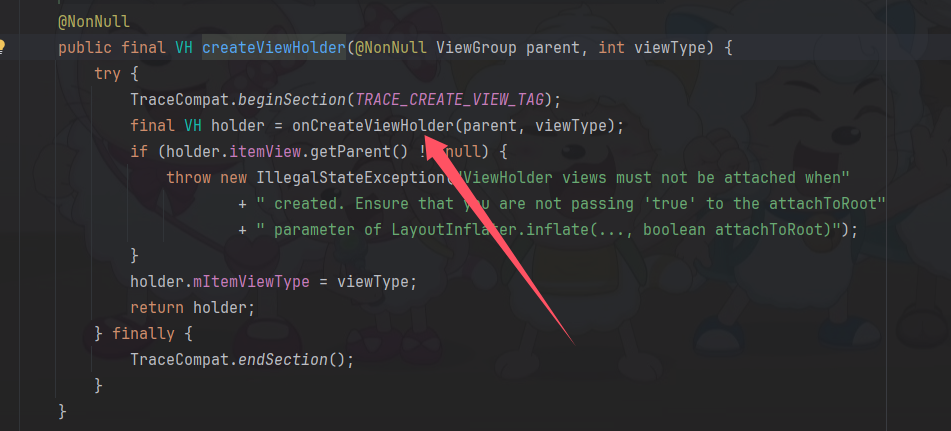

就可以找到我们每次写Adapter都用重写的 onCreateViewHolder方法了。
在后面的代码中,我们依次点击:
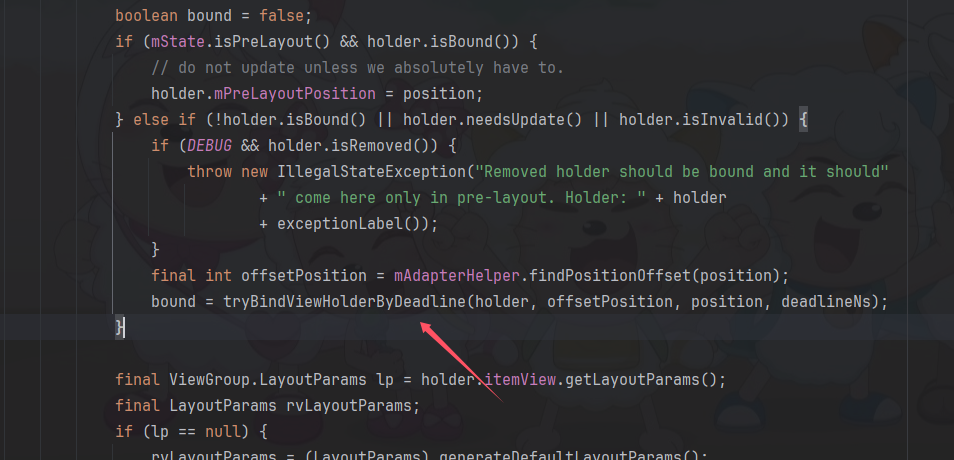
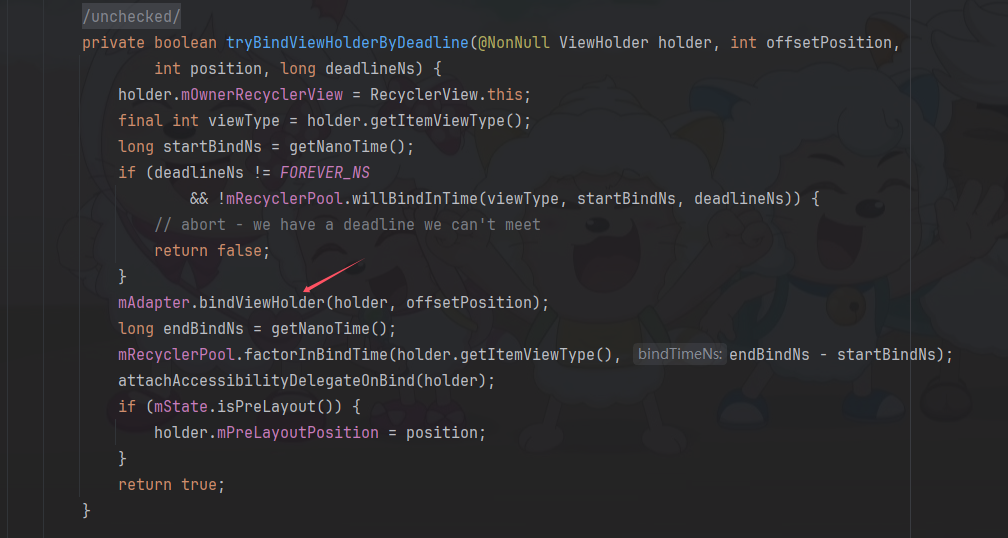
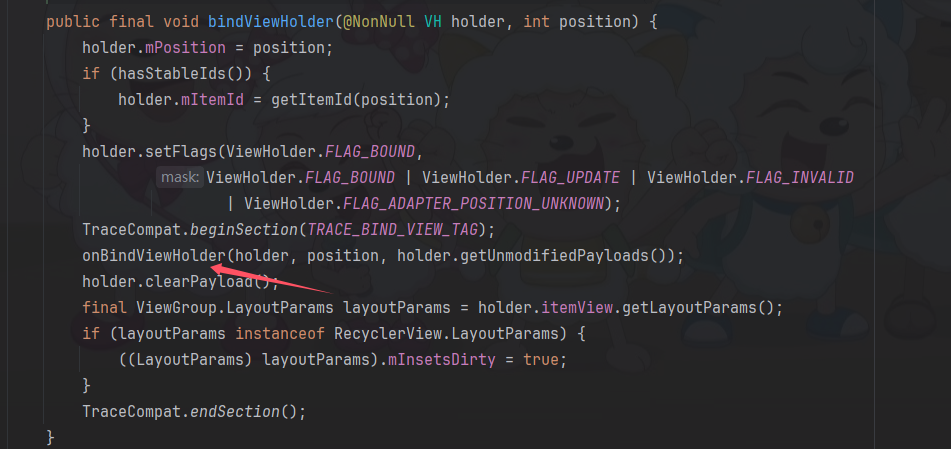


就可以找到我们每次写Adapter都用重写的 onBindViewHolder方法了。
已经到底啦!!




基础 | 目标网站)


)


, 全字段校验,批次等操作(全))







)
